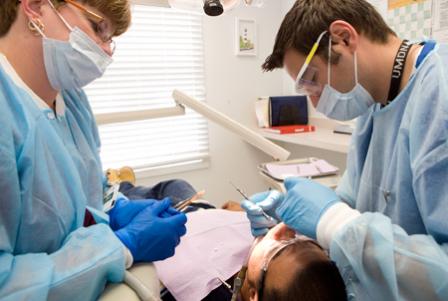Dental Effluent Guidelines
 EPA is promulgating pretreatment standards to reduce discharges of mercury from dental offices into publicly owned treatment works
EPA is promulgating pretreatment standards to reduce discharges of mercury from dental offices into publicly owned treatment worksDental offices discharge mercury present in amalgam used for fillings. Amalgam separators are a practical, affordable and readily available technology for capturing mercury and other metals before they are discharged into sewers that drain to POTWs. Once captured by a separator, mercury can be recycled.
Existing dental offices must comply within three years after the effective date of the rule. EPA expects compliance with this final rule will annually reduce the discharge of mercury by 5.1 tons as well as 5.3 tons of other metals found in waste dental amalgam to POTWs.
Background
Mercury is a potent neurotoxin that bioaccumulates in fish and shellfish. Mercury pollution is widespread and a global concern that originates from many diverse sources such as air deposition from municipal and industrial incinerators and combustion of fossil fuels.
- Dental clinics are the main source of mercury discharges to POTWs.
- EPA estimates about 103,000 dental offices use or remove amalgam in the United States; almost all of these send their wastewater to POTWs.
- Dentists discharge approximately 5.1 tons of mercury each year to POTWs; most of this mercury is subsequently released to the environment.
Mercury-containing amalgam wastes may find their way into the environment when new fillings are placed or old mercury-containing fillings are drilled out and waste amalgam materials that are flushed into chair-side drains enter the wastewater stream. Mercury entering POTWs frequently partitions into the sludge, the solid material that remains after wastewater is treated. Mercury from waste amalgam therefore can make its way into the environment from the POTW through the incineration, landfilling, or land application of sludge or through surface water discharge.
Compliance
The Federal Register notice for the final rule is not yet published. A pre-publication version is available below. EPA will update this web page when the rule is published. The effective date of the rule will be 30 days after publication.
Existing Dental Offices
Existing dental offices must comply within three years after the effective date of the rule.
New Dental Offices
The compliance date for new dental offices ("new sources") is the effective date of the rule.
Reporting Requirements
Existing and new sources must submit a one-time compliance report. See the Federal Register notice for details. EPA has not prepared an example compliance report at this time.
Documents
Final Rule
- Final rule (signed December 15, 2016)
The final rule has been signed by the EPA Administrator and is being prepared for publication. - Fact sheet
Additional documents related to this rulemaking can be found on EPA’s docket at regulations.gov. The Docket Number is EPA-HQ-OW-2014-0693.
Proposed Rule
- Proposed rule (October 22, 2014)
Additional Information
For additional information regarding the Dental Effluent Guidelines final rule, please email dentalamalgamfinalrule@epa.gov .
